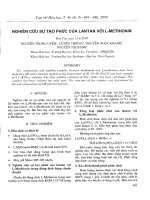02Clc_Nhom 06_Lich Su Tao Dang.pptx
Bạn đang xem bản rút gọn của tài liệu. Xem và tải ngay bản đầy đủ của tài liệu tại đây (10.94 MB, 53 trang )
History of Industrial Design
Lịch sử tạo dáng
Chapter 11 Modernism after World War II
From Theory to Practice
Dr. Tran Tien Anh
Ho Chi Minh city University of Technology (HCMUT)
Contents
1.The impact of shortages and rations on post World War II design activities.
2.PROMOTING POSTWAR DESIGN: ART DIRECTION AND THE NEW ADVERTISING
3.GRAPHIC DESIGN AND TECHNICAL INFORMATION
4. SCANDINAVIA AND BRITAIN
5.ITALY
6.GERMANY
7.THE INTERNATIONAL TYPOGRAPHIC STYLE(DIE NEUE GRAFIK )
8.M EA N S AN D E NDS
9.JAPAN
10.DESIGN AND CORPORATE CULTURE
11.TRADE MARKS AND BEYOND
06/11/2023
Dr. Tran Tien Anh@HCMUT
2
1.The impact of shortages and rations on post World War II design activities.
• The end of World War II, especially in Britain, economic recovery, optimism, and consumer confidence were
stimulated by the example of the United States and by the staging of national and international exhibitions such as
the Milan Triennale and the Festival of Britain (1951), the latter commemorating the centennial of the Crystal
Palace Exhibition.
• In 1947, Earl Tupper (1907-1983) began to market Tupperware (the company was founded in 1945), a line of
flexible plastic storage and serving containers with self-sealing airtight lids to prevent spilling and preserve
freshness (fig. 11.1). Tupperware utilized smooth, simple, often stackable forms and standardized sizes that
permitted interchangeability for lids.
• Tupper's commercial success dated to the 1950s, but was based upon his invention of a new pliable plastic called
Poly-T in 1942, manufactured by DuPont and other chemical compan ies as part of the war effort. This interest in
harnessing wartime technologies and high-volume industrial production to improve domestic living through new,
inexpensive,
and practical products played a large role in shaping positive attitudes toward modern design in the decade following
the end of World War II. It also helps to explain the leading role assumed by large chemical corporations in
promoting modern design, as it enabled them to sustain, if not increase, production during peacetime. Chemical and
pharmaceutical companies employed graphic designers who helped to explain and promote scientific concepts and
their useful applications in visual terms to the public and
to the business community through popular and professional magazines and journals
• A series of Bubble hanging lamps
were designed by George Nelson Associates beginning in 1952 and manufactured by the Michigan-based Howard
Miller Clock Company. The lamps were constructed from steel wire attached to rings (rather than welded) and
sprayed with a plastic to create translucent shells in a variety ofrounded shapes (fig. 11.2)
• Dreyfuss published his The Measure of Man:
Human Factors in Design in 1960 (fig. 1r.3), a manual of detailed drawings in which measurement forms the basis of
design decisions. Using a series of average body sizes for men and for women that took into account differences, The
Measure of Man used observation and measurement to determine heights of tables, distances between operators and
machines or appliances, and the form and placement of knobs and controls on devices for ease-of-use, safety, and the
reduction of error.
• From the early 1940s, the new model did not appear until 1953- Adapting the tnermostat mechanisms to a round
housing necessitated significant invention, credited to the company engineer Carl Kronmiller (1889-1968), who
developed a spring coil to replace the conventional glassenclosed mercury-filled thermometer that was difficult
to manufacture in a curved form. While the costs of development were considerable, the final manufactured
product was less expensive than earlier models. Dreyfuss liked the idea of the round control from the standpoint
of mounting, that is, rectangular models almost always looked crooked when mounted on the wall. A further
refinement that Dreyfuss developed was a concentric metal plate that fitted easily around the clear plastic
readout and control. He was also responsible for suggesting that the concentric plate be manufactured in a
variety of colors to match the wall. Dreyfuss's name was frequently mentioned in advertising campaigns, but the
development process of this product began before he was hired and required considerable collaborative effort.
Inexpensive, easy to operate, inconspicuous, and attractive in its simple and concentric forms, the Honeywell
Round demonstrated the advantages of postwar industrial design, and companies often promoted the integral and
creative role of the industrial designer as a marketing tactic
• Unlike earlier plywoodmolding techniques used, for instance, by Alvar Aalto, theEameses' approach to
molding was three-dimensional -what design historian Peter Dormer has called "vessel andvalley" forms as
a reference to their more organic,sculptural character.***In 1946, the Eameses designed a molded
plywoodchair with separate seat and back supported by a thin ,welded tubular steel frame and mounted with
rubbershocks, eventually manufactured by Herman Miller (fig.11.5). The couple continued to experiment
with moldedplywood and fiberglass for furniture in the later 1940s,and their unupholstered dining armchair
of 1950, a singlepiece combining armrests, seat, and back, also mountedon a tubular metal frame, won
another internationalcompetition sponsored by the Museum of Modern Art for"Low-Cost Furniture." In
1954, an armless, stackingversion of the fiberglass chair was introduced by Miller,and became immensely
successful for seating in schoolsand other institutions by virtue of its light weight andability to be easily
stored and moved.
.
• Mechanized production and industrial technology were not only the agents of improved efficiency but also of an
emerging aesthetic ofbiomorphic sculptural forms. The Eameses, for instance, explored the organicism of molded
plywood in his well-known lounge chair and footstool, designed for Herman Miller beginning in 1956 (fig. 11.6).
This chair was constructed of three separate pieces of molded plywood, upholstered in leather, and supported by a
five-legged metal pedestal base. The Eameses' lounge chair relates to individual comfort, abstract sculptural form,
and expense beyond the earlier "low-cost" furniture, indicating motivations extending beyond efficiency
In addition to a continuous supply of new designs with advantages to the consumer in terms of comfort, lightness,
efficiency, or beauty, marketing strategies focused upon the individual designer, who lent uniqueness to serially
manufactured goods. Herman Miller, for instance, manufactured abstract sculptural designs by Japanese-American
artist Isamu Noguchi (1904-1988), such as his glass table (fig. 11.7), which is supported by an ebonized wood base
consisting of two irregular forms, suggestive of Automatic Surrealism. Although elements of the egalitarian social
ideology of the first machine age remained after World War II, it was the transformation of that ideology that often
best exemplifies postwar modernism, especially in the 1950s. This transformation produced a benevolent "marriage
of commerce and culture," in which an elevated taste merged with increasing production and economic prosperity
• Another development of postwar modem design infurniture manufacturing was modularity, seen for
instin storage and shelving, which had appeared earlier inEliot Noyes's vision of"organic design" for the
Museum olModem Art exhibition of1940-1941 (see page 249). EeroSaarinen and Charles Eames
designed a series of modula1units for domestic interiors for the Red Lion Company inPennsylvania,
which were constructed of plywood withdowel-like legs and sliding doors for cabinets. The Eames!
>small shelving units, known as the ESU system, designedfor Miller (fig. 11.9), used light steel bracing
for strengthand support, as well as rectangular molded plywoodsliding doors with embossed circular des
• The refinement of the Eameses' lounge chair and subsequent office chair designs in cast aluminum was also
incorporated into furniture designs manufactured by German emigre Hans Knoll, who established Knoll
Associates in 1943. Knoll's wife and partner, Florence Schust Knoll (b. 1917), studied at the Cranbrook Academy
in Bloomfield Hills, Michigan, and did much to establish the company's association with modern design after
World War II. Knoll manufactured the furniture prototypes ofarchitect and former director ofthe Bauhaus, Mies
van der Rohe (see page 204), for instance, his steel and upholstered leather Barcelona chair designed for the
German Pavilion at the 1929 international exhibition held in Spain
The company also produced designs by Cranbrook faculty and students such as the Italian-born sculptor Harry
Bertoia (1915-1978) . Bertoia's Diamond chair made of spot-welded steel (fig. II.II) was manufactured by Knoll
from 1952 and features the molded "vessel and valley" forms also seen in plywood and plastic designs for chairs
by Saarinen and Eames (see page 263). Bertoia had worked with Eames on molded plywood designs in
California. The chair's form approximates an abstract approach to the wingspan of a bird in flight, enhanced
through the open and elastic weblike treatment of the welded steel wires
.
• A more restrained sculptural aesthetic is seen in the interior design of passenger airplanes, in particular Walter
Teague's design for the Boeing 707 aircraft of 1955-1956 (fig. n.12). Like Henry Dreyfuss, Teague established his
reputation as a consultant industrial designer in the interwar period and was committed to a consideration of
human factors and an understanding of manufacturing processes in products such as the 1936 Kodak Bantam
camera (see fig. 10.23). Teague's airline interior demonstrates a preference for recessed indirect lighting and
curving molded plastic surfaces without projections or intrusive patterned decoration; such features respectedA
more restrained sculptural aesthetic is seen in the interior design of passenger airplanes, in particular Walter
Teague's design for the Boeing 707 aircraft of 1955-1956 (fig. n.12). Like Henry Dreyfuss, Teague established his
reputation as a consultant industrial designer in the interwar period and was committed to a consideration of
human factors and an understanding of manufacturing processes in products such as the 1936 Kodak Bantam
camera (see fig. 10.23). Teague's airline interior demonstrates a preference for recessed indirect lighting and
curving molded plastic surfaces without projections or intrusive patterned decoration; such features respecte
concerns for safety and had a calming psychological effect, tested through the construction of a full-scale interim
model to study and measure passenger reaction prior to manufacturing. Teague remained a vigorous spokesma,
for research and a range of determinants in design that moved beyond functional aesthetics toward observing and
respecting the experience of users. Such an approach was articulated in books and in articles published in the
journal Industrial Design; in a broad sense it reflects a designer's role in mediating between products and users of
considering options and making decisions that affect our relationship to complex technologies
2. PROMOTING POSTWAR DESIGN: ART
DIRECTION AND THE NEW ADVERTISING
-Modern designs also provided the setting for Hollywood films such as The Man in the Grey Flannel Suit
(1956), and were visible in manufacturer showrooms and in department store windows in major
cities across the United States.
-Modern interiors were also featured in masscirculation magazines in the early 1950s, such as Better Homes
and Gardens (fig. 11.14)
Graphic designer Herbert Matter used the inventive pedestal support for the Saarinen chair, labeled the Tulip
chair, as the basis for surprise in a well-known advertisement on two successive pages for Knoll (fig. ru5; the
first page of the advertisement shows the pedestal with seat and back covered with brown wrapping paper).
-The female model wears pants rather than a dress or skirt, and her informal pose suggests a casual, elegant
ideal of modern living.
Rand's 1946 copy-less magazine advertisement for Coronet Brandy (fig. rr.r6) features a collage of cocktail glasses being effortlessly juggled by a
waiter whose head is shaped like that of a brandy snifter. Rand's approach to visual communication stressed creative solutions to the presentation of
products in which the artist's originality and engagement of the viewer's interest through surprise, symbol, and humor were compatible and satisfying to
the client.
The role of the designer and his most important "must" is to remain free, as free as he possibly Cu from the prejudices and the ruts which affect so ma1
others in the field of design. He must be constantly , guard, cleansing his mind of the tendency to relax int, a routine format, ready to experiment, play,
cha not, and alter forms. If he lacks the inherent ability, thin sight, the intuitive selection of what is right for hi time, he will not go far and will
eventually be forced t"' enter another field. If he is equipped with these essr1tial characteristics, he will lead the way to new and more effective
approaches to design in all its forms
A book cover by Lustig for Rimbaud's A Season in Hell from 1945 uses an asymmetrical arrangement of
amorphous shapes reminiscent of Joan Mir6's paintings against a fiery red background (fig. 1u8). The theme of
duality is suggested by the division of the shapes into equal areas of black and white. While the red background
may suggest an inferno, the lettering with its small circles as serifs resembles the star-filled heavens. The
application of a wide range of creative. Open end solutions to design problems or challenges helps to define the
individual character of postwar graphic design in a context that permitted artistic freedom.
-The clever manipulation of type and use of photography helped to define the role of graphic design in
communicating a mood or conveying an idea visually on a cover that was the subject of a feature article inside
the journal. An example is Wolf's Esquire cover from 1958 illustrating a wine glass filled with water into which
a packet of powdered "wine" has been sprinkled (fig. n.20). Below the text reads "The Americanization of Paris"
in a bold sans serif mixing blue and red colors. The classic and simple wine glass (one may remember Beatrice
Warde's essay "The Crystal Goblet," see pages 216- 217) connotes a time-honored product associated v. rith
France, while the paper packet refers to the instant gratification that often characterized American culture at the
time. The clash and interrelationship between two Western cultures are conveyed in the juxtaposition of symbols
that are readily understood in connection with the text whose colors stand for the flags of both nations.
• The careful and expressive sequencing of images combined with text and titles emerged as well in Ballet(1945), a
volume of black-and-white photographs by Alexey Brodovit ch (fig. n.21). Brodovit ch (see page 247) used the
blurred and bled images of dancers, often caught off. Guard and cut by the edge of the page in an effect
reminiscent of the paintings of Edgar Degas.
Utilizing an increasingly broad array of
techniques derived from modern art, elements
of the New Typography, and creative latitude,
advertising designers and magazine art
directors brought visual excitement and
intellectual sophistication to the presentation
of products and to features focused upon the
character ofmodern living as revealed in travel,
fashion, entertainment, and cuisine. Editorial
features also addressed contemporary political and
social issues and permitted considerable freedom of
expression. The combination of creative freedom with
the effective visual communication of ideas provided
an ethos that defined a progressive role for the graphic
designer. That role echoed themes familiar from
design reform, namely raising the level of public
aware-ness ofdesign and harmonizing individual
freedom and expression with responsibility in visual
communication.
3.GRAPHIC DESIGN AND TECHNICAL INFORMATION
During World War II, German-born graphic designer Will Burt in used the elements of graphic presentation to
produce training manuals to teach air force crewmen to understand and operate complex aerial guns (see page 252)..
Translating information into effective graphic design was a creative act of problem solving as well as a form of
public education and service. Cover designs were highly suggestive: juxtapositions between technical drawing,
photography, and painting, with roots in Dada and Surrealist photomontage and collage in the interwar period,
stimulated a creative, imaginative reading of medical research developments for an audience less familiar with
particular technical knowledge of tl1e field, while charts accompanying articles within the magazine clarified new
research developments and their applications (fig. u .23). Burt in's efforts for Upjohn were not limited to the printed
page.
In 1959, the Eameses designed a multi-screen display for the American National Exhibition in Moscow
that featured images of technology and everyday life with a running time of just over 12 minutes.
Informational exhibits became an important part of the consultancy's design activities, which included a
series of exhibits for the IBM Corporation (see fig. n.86). Postwar designers such as Burtin and the
Eameses saw themselves as contributing, through information design, to the shaping of a shared belief a nd
public confidence in broad cultural progress through technology within the framework of corporate
capitalism and government investment.. Burtin occasionally used the services of the Czechoslovakian
designer Ladislav Sutnar (1897- 1976s). This may suggest variation, as among the living standards of
different parts of the world, or progress, as from the time of the earliest American settlers to the present. In
short, the word has potential for implying something dynamic, not static - something which is always
changing, advancing.
Sutnar brought the same clarity and order to the creation of unified graphic standards for Carr's self-service
department stores in New Jersey (1956-1957), and a system of easily recognized symbols for the Bell Telephone
Company. Both projects are examples of the adoption of visual systems for identifying products and communicating a
sense of organization through visual order and consistency. Such work made Sutnar a pioneer in the development of
"house styles" for many large businesses in the postwar era. Bauhaus student and instructor Herbert Bayer, who
settled in the United States in 1938, produced one of the richest examples of information graphics, the World
Geographic Atlas, published in 1953 by the Container Corporation of America (CCA). It featured technical
information in a rich variety of subject areas related to geography, climate, and natural resources









